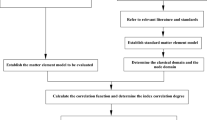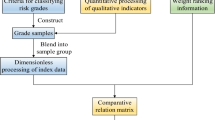Abstract
The multi-level evaluation system and rock slope stability were analyzed in this study based on extension and systems engineering theory. An appropriate evaluation index system was selected through hierarchical analysis of geological conditions, excavation and supporting measures, and environmental and monitoring layouts. The comprehensive evaluation system was then divided into three layers: index, description, and target layers. The system can be adopted to conduct a thorough and careful investigation of the research object. The technique matter-element extension transform was employed in the extension model to solve the multi-attribute problem and to prevent incompatibility in rock slope stability evaluation. Qualitative and quantitative grade evaluations were performed by calculating the matter-element dependency degree. The model was then applied to a large-scale rock slope project, and its evaluation criteria for rock slope stability were established. Results were verified through quantitative method of 3D limit equilibrium and qualitative method of 3D nephrogram displacement variation. Results show that extension theory can be utilized to solve problems in rock slope safety.






Similar content being viewed by others
References
Bieniawski ZT (1989) Engineering rock mass classifications [M]. Wiley, New York
Cai W (1999) Extension theory and its application. Chin Sci Bull 44:1538–1548
Cai W, Yang C, Weichu L (2003) Extension engineering methods [M]. Science Press, Beijing (in Chinese)
Chenzuyu (2004) Rock slope stability analysis: theory, methods and program. China Water Power Press (in Chinese)
Corporation HCE (2004) Feasibility study report of Jinping I level hydropower station [R]. Chengdu (in Chinese)
Crosta G, Agliardi F (2003) Failure forecast for large rock slides by surface displacement measurements. Can Geotech J 40:176–191
Duncan JM (1996) State of the art: limit equilibrium and finite-element analysis of slopes. J Geotech Eng 122:577–596
Ghaboussi J, Barbosa R (1990) Three-dimensional discrete element method for granular materials. Int J Numer Anal Meth Geomech 14:451–472
Hewitt K (2006) Disturbance regime landscapes: mountain drainage systems interrupted by large rockslides. Prog Phys Geogr 30:365–393
Huang YH (1983) Stability analysis of earth slopes [M]. Van Nostrand Reinhold, New York
Kamai T (1998) Monitoring the process of ground failure in repeated landslides and associated stability assessments. Eng Geol 50:71–84
Kane WF, Beck TJ (1996) Rapid slope monitoring. Civil Eng 66(6)
Mauritsch HJ, Seiberl W, Arndt R, Römer A, Schneiderbauer K, Sendlhofer GP (2000) Geophysical investigations of large landslides in the Carnic Region of southern Austria. Eng Geol 56:373–388
Mora S, Madrigal C, Estrada J, Schuster R (1993) The 1992 Rio Toro Landslide Dam, Costa Rica. Landslide News 7:19–22
Purer E, Steiner N (1986) Application of statistical methods in monitoring dam behaviour. Int Water Power Dam Constr 38:33–35
Qian Z-H, Hong Y, Xu C-Y, Ren L-Q (2009) A biological coupling extension model and coupling element identification. J Bionic Eng 6:186–195
Qiao Z (2010) Study on decision support method based on Extenics and BP Neural Network. In: Fuzzy Systems and Knowledge Discovery (FSKD), 2010 Seventh International Conference on IEEE, pp 1055–1059
Runqiu H (2007) Large-scale landslides and their sliding mechanisms in China since the 20th century. Chin J Rock Mech Eng 26:433–454 (in Chinese)
Segalini A, Giani G (2004) Numerical model for the analysis of the evolution mechanisms of the Grossgufer rock slide. Rock Mech Rock Eng 37:151–168
Simeoni L, Proietti T, Mongiovì L (2003) Analysis and prediction of slow landslide evolutions by using automatic displacement monitoring systems—technology roadmap for rock mechanics. In: Proceedings of International Symposium on Rock Mechanics, pp 1077–1082
The Ministry of Water Resources of the People's Republic of China, GB50218 (1995) Standard for engineering classification of rock masses [S]. China Planning Press, Beijing (in Chinese)
The Ministry of Water Resources of the People's Republic of China, GB50287 (1999) Code for water resources and hydropower engineering geological investigation [S]. China Planning Press, Beijing (in Chinese)
Tu X, Dai F, Lu X, Zhong H (2007) Toppling and stabilization of the intake slope for the Fengtan Hydropower Station enlargement project, Mid-South China. Eng Geol 91:152–167
Zheng G, Jing Y, Huang H, Zhang X, Gao Y (2009) Application of Life Cycle Assessment (LCA) and extenics theory for building energy conservation assessment. Energy 34:1870–1879
Zhou H, Zhang G, Wang G (2007) Multi-objective decision making approach based on entropy weights for reservoir flood control operation. J Hydraul Eng 1:014 (in Chinese)
Acknowledgments
The work presented in this paper was financially supported by the National Basic Research Programme of China (973 Programme) (Grant No. 2011CB013504); the National Natural Science Foundation of China (Grant No. 50909038) and Research Innovation Project of Science and Technology for College graduates in Jiangsu Province (Grant No. CXLX12_0242). We also acknowledge the editor and reviewers for their valuable suggestions.
Author information
Authors and Affiliations
Corresponding author
Rights and permissions
About this article
Cite this article
Zhao, B., Xu, W.Y., Liang, G.L. et al. Stability evaluation model for high rock slope based on element extension theory. Bull Eng Geol Environ 74, 301–314 (2015). https://doi.org/10.1007/s10064-014-0615-7
Received:
Accepted:
Published:
Issue Date:
DOI: https://doi.org/10.1007/s10064-014-0615-7




